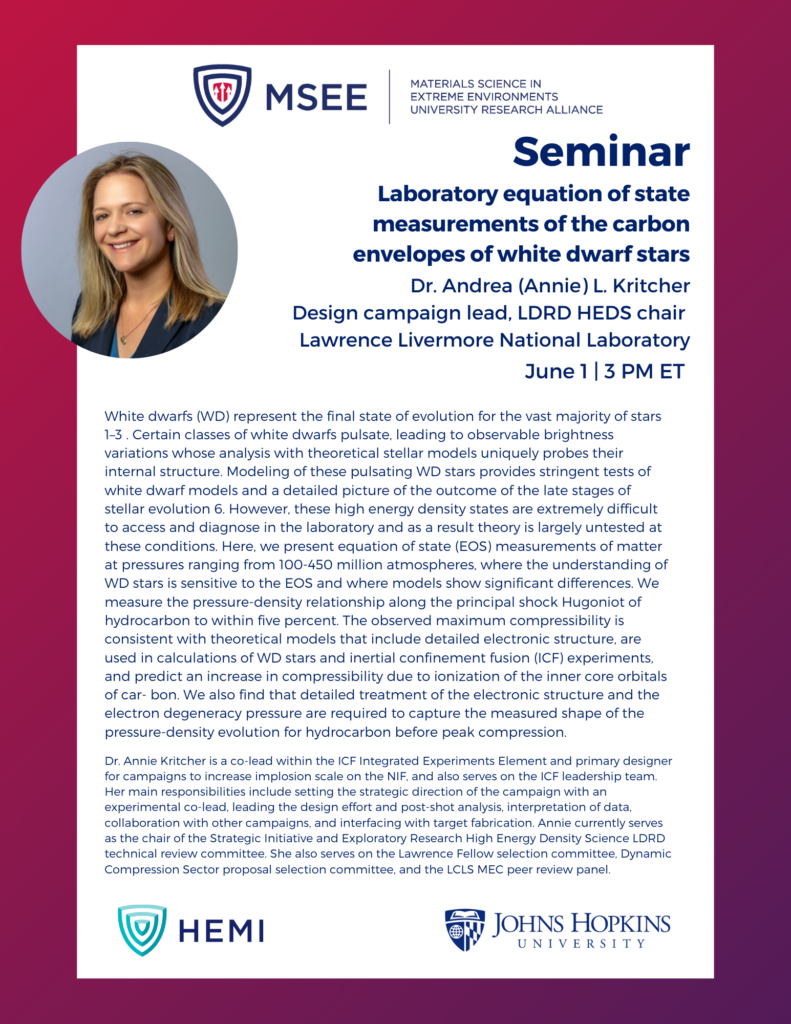Laboratory equation of state measurements of the carbon envelopes of white dwarf stars
Please contact Rachel Wise at [email protected] for connection information.
White dwarfs (WD) represent the final state of evolution for the vast majority of stars 1–3 . Certain classes of white dwarfs pulsate4, 5 , leading to observable brightness variations whose analysis with theoretical stellar models uniquely probes their internal structure. Modeling of these pulsating WD stars provides stringent tests of white dwarf models and a detailed picture of the outcome of the late stages of stellar evolution 6. However, these high energy density states are extremely difficult to access and diagnose in the laboratory and as a result theory is largely untested at these conditions. Here, we present equation of state (EOS) measurements of matter at pressures ranging from 100-450 million atmospheres, where the understanding of WD stars is sensitive to the EOS and where models show significant differences. We measure the pressure-density relationship along the principal shock Hugoniot of hydrocarbon to within five percent. The observed maximum compressibility is consistent with theoretical models that include detailed electronic structure, are used in calculations of WD stars and inertial confinement fusion (ICF) experiments7, 8 , and predict an increase in compressibility due to ionization of the inner core orbitals of car- bon. We also find that detailed treatment of the electronic structure and the electron degeneracy pressure are required to capture the measured shape of the pressure-density evolution for hydrocarbon before peak compression.
Dr. Annie Kritcher is a co-lead within the ICF Integrated Experiments Element and primary designer for campaigns to increase implosion scale on the NIF, and also serves on the ICF leadership team. Her main responsibilities include setting the strategic direction of the campaign with an experimental co-lead, leading the design effort and post-shot analysis, interpretation of data, collaboration with other campaigns, and interfacing with target fabrication. Annie currently serves as the chair of the Strategic Initiative and Exploratory Research High Energy Density Science LDRD technical review committee. She also serves on the Lawrence Fellow selection committee, Dynamic Compression Sector proposal selection committee, and the LCLS MEC peer review panel.
Annie was first employed at the Lab as a summer intern in 2004, as an LLNL Lawrence Scholar during her time at UC Berkeley, and as a Lawrence postdoctoral fellow in 2009 following completion of her Ph.D. Annie’s thesis on experimental measurements of X-ray Thomson Scattering to diagnose high energy density matter was conducted at the Jupiter laser facility (LLNL) and Omega laser facility (Rochester). During her postdoctoral appointment she continued her work on X-ray Thomson Scattering, investigated nuclear plasma interactions, and co-lead a campaign to measure the equation of state of materials to hundreds of Mbars. She also obtained an LDRD to continue this project after her postdoc. Following her postdoc she transitioned from experimental physics to design physics within the Design Physics directorate at LLNL where her main focuses included assessing the impact of low mode asymmetries on ICF implosions, ICF ablator material comparison, and increasing ICF implosion scale.





